Pisces constellation lies in the northern sky. Its name means “the fish” (plural) in Latin.
Pisces is one of the largest constellations in the sky. It is one of the zodiac constellations, first catalogued by the Greek astronomer Ptolemy in the 2nd century. Its symbol is ♓.
Pisces lies between Aries constellation to the east and Aquarius to the west. The two celestial fish represent Venus and Cupid in Roman mythology, who transformed themselves into fish in order to escape the monster Typhon. The Vernal equinox, the point at which the Sun moves to the northern hemisphere across the equator every year, is currently located in Pisces.
Pisces constellation also contains a number of interesting deep sky objects, among them the face-on grand design spiral galaxy Messier 74 (NGC 628), the Pisces Dwarf galaxy, the double radio galaxy 3C 31, and the colliding galaxy pair Arp 284.
Facts, location and map
Pisces is the 14th constellation in size, occupying an area of 889 square degrees. It is one of the 15 equatorial constellations. It is located in the first quadrant of the northern hemisphere (NQ1) and can be seen at latitudes between +90° and -65°. The neighboring constellations are Andromeda, Aquarius, Aries, Cetus, Pegasus and Triangulum.
The constellation name Pisces is pronounced /ˈpaɪsiːz/. In English, the constellation is known as the Fishes. The genitive form of Piscis, used in star names, is Piscium (pronunciation: /ˈpɪʃiəm/). The three-letter abbreviation, adopted by the International Astronomical Union (IAU) in 1922, is Psc.
Pisces belongs to the zodiac family of constellations, along with Aries, Taurus, Gemini, Cancer, Leo, Virgo, Libra, Scorpius, Sagittarius, Capricornus and Aquarius.
Pisces contains a single Messier object, the spiral galaxy Messier 74 (M74, NGC 628) and has ten stars with known planets. The brightest star in the constellation is Alpherg (Eta Piscium), with an apparent magnitude of 3.62. There is one meteor shower associated with the constellation; the Piscids.
Pisces contains nine named stars. The star names approved by the International Astronomical Union (IAU) are Alpherg, Alrescha, Bélénos, Citadelle, Ebla, Fumalsamakah, Parumleo, Revati, and Torcular.
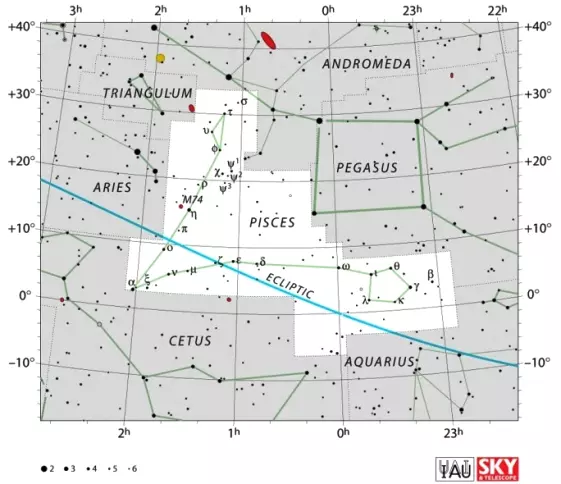
Pisces constellation map by IAU and Sky&Telescope magazine
Myth
Pisces constellation is of Babylonian origin. The Babylonians saw it as a pair of fish joined by a cord. The constellation is usually associated with the Roman myth of Venus and Cupid, who tied themselves with a rope and transformed into fish to escape the monster Typhon. The star Alpha Piscium, also known by the traditional name Alrescha (“the cord” in Arabic) marks the knot of the rope.
The constellation is associated with a similar story in Greek mythology. After the Olympian gods had defeated the Titans and the Giants, Gaia, or Mother Earth, coupled with Tartarus, the region of the Underworld where Zeus held the Titans imprisoned, and they had Typhon, the scariest monster the world had ever seen. Typhon had a hundred dragon’s heads, with fire blazing from all his eyes. Gaia sent Typhon to defeat the gods. Pan was the first to see him coming.
He alerted the other gods and then transformed himself into a goat-fish and jumped into the river Euphrates to escape the monster. The goat-fish is represented by the constellation Capricornus.
The goddess Aphrodite and her son Eros called to the water nymphs for help and jumped into the river. In one version of the legend, two fishes came to the rescue and carried Aphrodite and Eros on their backs to safety. In another version, the mother and son were themselves transformed into fish.
Major stars in Pisces
Alpherg – η Piscium (Eta Piscium)
Eta Piscium is the brightest star in Pisces. It lies approximately 350 light years away. It is a yellow giant of the spectral type G7 IIIa with a mass of about 3.78 solar masses and a radius 26.48 times that of the Sun. With an effective temperature of 4,937 K, Alpherg is 457 times more luminous than the Sun. It has an estimated age of 220 million years.
The star has an apparent magnitude of 3.83. It forms a binary system with a fainter, magnitude 7.51 companion. The system has a combined visual magnitude of 3.611.
The name Alpherg comes from the star’s traditional name, Al Pherg, meaning “the spout” or “the outpouring of water.” The name was formally approved by the International Astronomical Union (IAU) in 2018.
Eta Piscium also has an older traditional name, Kullat Nunu. Nunu is the Babylonian word for “fish,” and “kullat” refers either to a bucket or the cord used to tie the fish together.
γ Piscium (Gamma Piscium)
Gamma Piscium is a yellow giant with the stellar classification of G9 III. It is the second brightest star in Pisces. It has an apparent magnitude of 3.699 and is approximately 138 light years distant. The star is ten times the size of the Sun and 61 times more luminous. It is believed to be about 5.5 billion years old.
The star is part of an asterism called the Circlet of Pisces, which represents the head of the western fish in Pisces constellation.
Gamma Piscium will not be in the Sun’s vicinity for long. The star moves three quarters of an arc second across the sky every year.
ω Piscium (Omega Piscium)
Omega Piscium is a yellow-white subgiant star with the stellar classification of F4IV. It has an apparent magnitude of 4.036 and is approximately 106 light years distant from the Sun. It is the first star to the east of the Circlet of Pisces.
The star is suspected to be a close binary system. If it is a single star, it is 1.8 times more massive than the Sun and 20 times more luminous.
ι Piscium (Iota Piscium)
Iota Piscium is a yellow-white dwarf with the stellar classification of F7 V. It has an apparent magnitude of 4.13 and is 44.73 light years distant from Earth. It is larger and more luminous than the Sun.
Iota Piscium is a suspected variable star, and it has two line-of-sight companions.
ο Piscium (Omicron Piscium)
Omicron Piscium is a yellow giant star with the stellar classification G8 III. It has an apparent magnitude of 4.26 and is approximately 142 light years distant. In the 1515 Almagest, the star was listed with the proper name Torcularis septentrionalis.
Alrescha – α Piscium (Alpha Piscium)
Alpha Piscium is a close binary star with components separated by 1.8 arc seconds. The primary star belongs to the spectral class A0p and has a visual magnitude of 4.33, and the companion belongs to the spectral class A3m and has an apparent magnitude of 5.23. The stars orbit each other with a period of over 700 years.
The primary star has 2.3 solar masses and is 31 times more luminous than the Sun, while the companion has 1.8 times the Sun’s mass and is 12 times brighter.
The name Alrescha (sometimes Al Rescha, Alrisha, or Alrischa) is derived from the Arabic al-rišā, which means “the well rope.” The star is also sometimes known as Kaitain and Okda. Okda is derived from uqdah, the Arabic word for “knot.”
Alpha Piscium has a combined apparent magnitude of 3.82 and is approximately 139 light years distant from the solar system.
ε Piscium (Epsilon Piscium)
Epsilon Piscium is an orange giant star belonging to the stellar class K0 III, slightly larger and more luminous than the Sun. It has an apparent magnitude of 4.28 and is approximately 182 light years distant from Earth. The star is a suspected occultation double, composed of two stars with the same magnitude separated by 0.25 arc second.
θ Piscium (Theta Piscium)
Theta Piscium has the stellar classification of K1 III, which means that the star is another orange giant. It has an apparent magnitude of 4.27 and is approximately 159 light years distant from the solar system. It is brighter, yet cooler than the Sun.
δ Piscium (Delta Piscium)
Delta Piscium is a binary star with an apparent magnitude of 4.43. It is approximately 305 light years distant from the Sun. It lies two degrees from the ecliptic and is regularly occulted by the Moon.
The primary star in the system is an orange giant with the stellar classification of K5 III. It is 380 times more luminous than the Sun and has a radius 43.1 times solar. The 13th magnitude companion is two arc minutes away and thought to be a K9-class dwarf or merely a star in the same line of sight.
ν Piscium (Nu Piscium)
Nu Piscium is an orange giant with the stellar classification K3IIIb. It has an apparent magnitude of 4.448 and is approximately 370 light years distant from the solar system. The star used to have the designation 51 Ceti.
Nu Piscium is cooler, yet larger and more luminous than the Sun. It has a mass 1.9 times solar and a radius 34 times that of the Sun.
Fumalsamakah – β Piscium (Beta Piscium)
Beta Piscium is a blue-white main sequence star with the stellar classification B6Ve. It has a visual magnitude of 4.53 and is approximately 492 light years distant from the Sun. The star’s traditional name, Fumalsamakah, comes from the Arabic phrase fum al-samakah, which means “the mouth of the fish.”
Van Maanen’s Star
Van Maanen’s Star (Van Maanen 2) is a white dwarf with the stellar classification DZ8. It is the third closest white dwarf to the Sun, after Sirius B in Canis Major constellation and Procyon B in Canis Minor. It is also the nearest known solitary white dwarf.
The stellar classification DZ8 indicates that the star has elements heavier than helium in its spectrum, which is to say metals.
The star was discovered by the Dutch-American astronomer Adriaan van Maanen in 1917. It has an apparent magnitude of 12.374 and is 14.1 light years distant from Earth. The star is located about two degrees south of Delta Piscium.
Van Maanen’s star has a mass 63 percent that of the Sun and only one percent of the solar radius. Its age is estimated to be around three billion years.
19 Piscium (TX Piscium)
19 Piscium is one of the reddest stars known. It has the stellar classification of C5III and is approximately 760 light years distant. The star has an apparent magnitude that varies between 4.9 and 5.5 magnitudes. It is a variable carbon star, which is to say a late type star with an atmosphere that contains more carbon than oxygen.
107 Piscium
107 Piscium is a main sequence star with the stellar classification K1V. It is an orange dwarf about 24.4 light years distant from the solar system. It is a variable star, exhibiting variations in magnitude from 5.14 to 5.26. Its age is estimated to be about 6 billion years. The star used to have the designation 2 Arietis. It has two visual companions.
96 G. Piscium (HD 4638)
96 G. Piscium is an orange main sequence dwarf belonging to the stellar class K2 V. It has a visual magnitude of 5.75 and is 24.31 light years distant from Earth. It is about 5.4 billion years old, which makes it slightly older than the Sun.
54 Piscium
54 Piscium is another orange dwarf in Pisces. It has an apparent magnitude of 5.88 and is 36.1 light years distant from the solar system. It has the stellar classification K0 V. The star has a confirmed planet in its orbit, discovered in 2002, and a brown dwarf was also discovered orbiting it in 2006.
54 Piscium has 76 percent of the Sun’s mass, 94.4 percent of the solar radius, and 46 percent of the Sun’s luminosity. It is about 6.4 billion years old.
The companion star, the brown dwarf, belongs to the stellar class T7.5V. It has a mass 50 times that of Jupiter, or 0.051 that of the Sun. It was the first brown dwarf discovered around a star that had a confirmed extrasolar planet in its orbit.
The planet has roughly the same mass as Saturn and orbits the star at a distance of 0.28 astronomical units, which corresponds to the orbit of Mercury. It takes 52 days to complete an orbit.
6 G. Piscium (HD 217107)
6 G. Piscium is a yellow subgiant star with the stellar classification of G8 IV. It has an apparent magnitude of 6.17 and is 64.8 light years distant from the Sun. It is older than the Sun and has a similar mass; 98 percent that of the Sun. The star is slightly larger, with a radius 1.31 times solar. It is believed to be about 7.7 billion years old.
Two planets have been detected orbiting the star. One completes an orbit every 7.1 days, while the other one takes eight years to complete an orbit.
Asterisms
The astronomer Johannes Hevelius divided Pisces into four subdivisions in his Firmamentum Sobiescianum in 1690: the North Fish (Piscis Boreus), the North Cord (Linum Boreum), the South Cord (Linum Austrinum), and the South Fish (Piscis Austrinus).
Piscis Boreus – The North Fish
Piscis Boreus is formed by the stars σ, 68, 65, 67, ψ1, ψ2, ψ3, χ, φ, υ, 91, τ, 82 and 78 Piscium.
Piscis Austrinus – The South Fish
Piscis Austrinus is formed by the stars ω, ι, θ, 7, β, 5, κ, 9, λ and TX (19) Piscium.
Linum Boreum – The North Cord
Linum Boreum is formed by the stars χ, ρ, 94, VX (97), η, π, ο and α Piscium.
Linum Austrinum – The South Cord
Linum Austrinum is formed by the stars α, ξ, ν, μ, ζ, ε, δ, 41, 35 and ω Piscium.
The Circlet of Pisces
The Circlet asterism is located south of Pegasus constellation, in the western fish of Pisces. It is formed by the stars Gamma, Kappa, Lambda, TX, Iota and Theta Piscium.
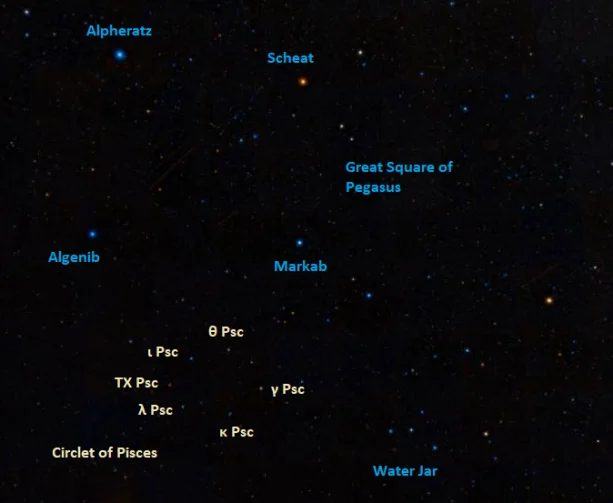
The Circlet of Pisces, the Great Square of Pegasus, and the Water Jar in Aquarius, image: Wikisky
Testudo – The Turtle
Testudo is formed by the stars 24, 27, YY(30), 33 and 29 Piscium. In 1754, the astronomer John Hill suggested that this region of Pisces should be a separate constellation, called Testudo, or the Turtle. His proposal was neglected by most astronomers at the time.
Deep sky objects in Pisces
Messier 74 (M74, NGC 628)
Messier 74 is a spiral galaxy seen face-on. It has an apparent magnitude of 10.0 and is approximately 30 million light years distant from the Sun. With two very clearly defined spiral arms, M74 is a textbook example of a grand design spiral galaxy. It is believed to contain about 100 billion stars.
M74 has a low surface brightness and of all the Messier objects it is the one most difficult for amateur astronomers to observe. It is located 1.5 degrees east-northeast of Eta Piscium, the brightest star in the constellation.
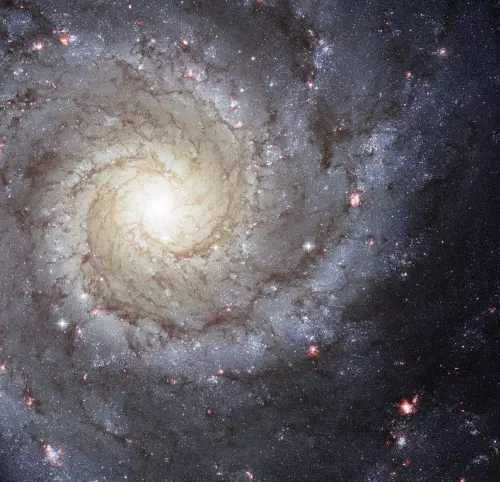
The grand-design spiral galaxy Messier 74 as photographed by the Hubble Space Telescope. Image: NASA, ESA, and the Hubble Heritage (STScI/AURA)-ESA/Hubble Collaboration. Acknowledgment: R. Chandar (University of Toledo) and J. Miller (University of Michigan)
The galaxy was discovered by the French astronomer Pierre Méchain, who notified Charles Messier of his discovery. Messier subsequently included the galaxy in his catalogue.
Two supernovae have been observed in Messier 74, SN 2002ap in 2002 and SN2003gd in 2003. SN2002ap was one of the rare Type Ic supernovae, also known as hypernovae, discovered in recent years. Hypernovae are supernovae events with a substantially higher amount of energy than regular supernovae, and are believed to be the origin of long-duration gamma-ray bursts, which are some of the most energetic events observed in space.
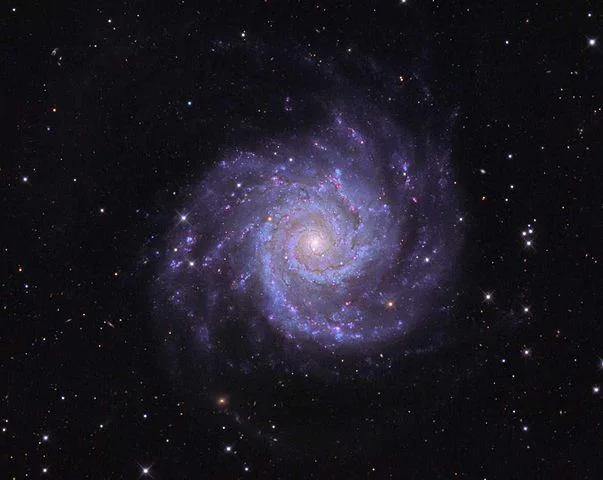
Messier 74, image: Adam Block/Mount Lemmon SkyCenter/University of Arizona (CC BY-SA 4.0)
In March 2005, an ultraluminous X-ray source was discovered in Messier 74 which emitted more X-ray power than a neutron star in periods of about every two hours, indicating the presence of an intermediate-mass black hole. The suspected black hole is believed to have a mass of 10,000 Suns. The X-ray source is designated as CXOU J013651.1+154547.
M74 Group
The M74 Group (or NGC 628 Group) is a small group of 5 to 7 galaxies in Pisces constellation, the brightest of which is Messier 74. Other members of the group include NGC 660, a peculiar spiral galaxy, and a few smaller irregular galaxies.
CL 0024+1654
CL 0024+1654 is a large galaxy cluster composed mainly of yellow elliptical and spiral galaxies. The cluster lenses a galaxy located behind it, which results in arc-like images of the galaxy in the background.
The cluster is approximately 3.6 billion light years distant, and the galaxy behind it is about 5.7 billion light years away.
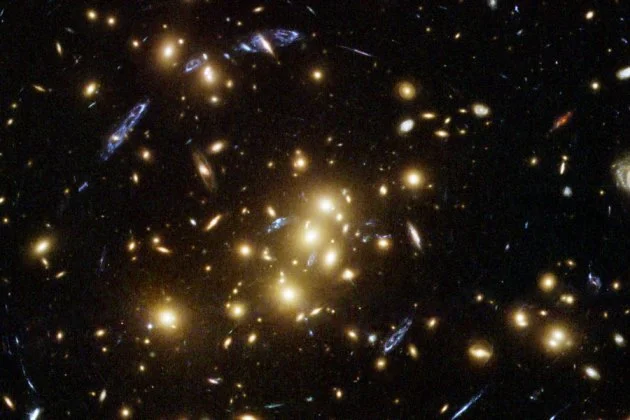
CL 0024+1654 – The distinctive shape of this background galaxy — which is probably just forming — has allowed astronomers to deduce that it has separate images at 4, 10, 11, and 12 o’clock, from the center of the cluster. A blue smudge near the cluster center is likely another image of the same background galaxy. In all, a recent analysis postulated that at least 33 images of 11 separate background galaxies are discernable. This spectacular photo of galaxy cluster CL0024+1654 from the Hubble Space Telescope was taken in November 2004. Image: NASA
NGC 7541
NGC 7541 is a barred spiral galaxy located about 103.7 million light years away. It stretches across 125,000 light years. It forms a pair with the neighbouring spiral galaxy NGC 7537.
NGC 7541 was discovered by William Herschel in August 1785.
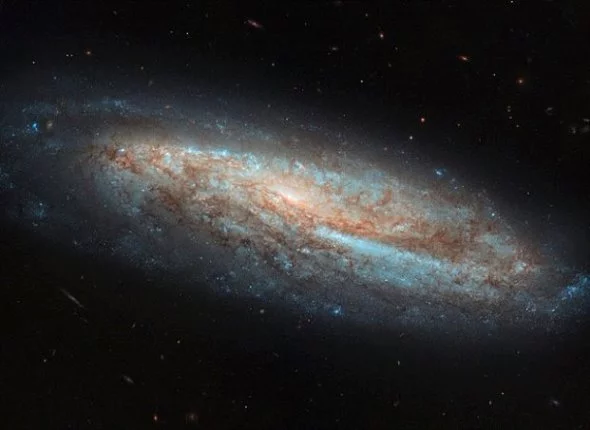
NGC 7541, image: ESA/Hubble & NASA, A. Riess et al., 2020
NGC 7537
NGC 7537 is another spiral galaxy in Pisces. It has an apparent magnitude of 13.9.
3C 31 (NGC 383)
3C 31 is a double radio galaxy about 209 million light years away in Pisces. It has a quasar-like appearance and is listed in The Arp Atlas of Peculiar Galaxies. The galaxy is a strong radio source.
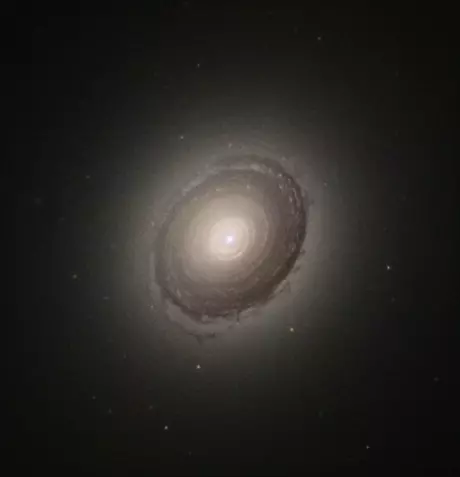
NGC 383, image: Judy Schmidt (CC BY 2.0)
3C 31 is an active galaxy with a supermassive black hole at its centre, one that causes the galaxy’s jets to extend for millions of light years in both directions.
The galaxy has an apparent magnitude of 13.4 and is approximately 209 million light years distant from the Sun. Four galaxies appearing in the vicinity – NGC 379, NGC 380, NGC 385 and NGC 384 – are believed to be closely associated with it.
CGCG 436-030 (PGC 4798)
CGCG 436-030 is a spiral galaxy in Pisces. It has an apparent magnitude of 14.9 and is approximately 400 million light years distant.
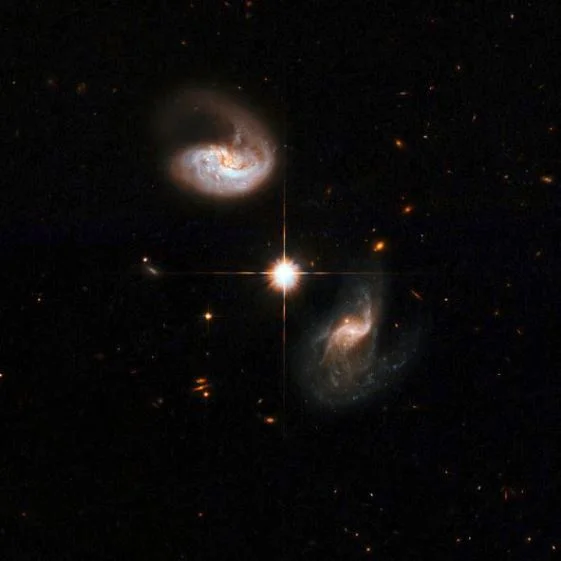
CGCG 436-030, the eye-catching spiral galaxy in the image, shows a very pronounced curling tail. The companion galaxy, located to the bottom-right of the image, displays an intricate structure, including a number of trails that extend quite far out from its core. The bright star that appears between the two galaxies does not belong to the interacting system and is located within the Milky Way. CGCG 436-030 is located in the constellation of Pisces, the Fish, about 400 million light-years away. This image is part of a large collection of 59 images of merging galaxies taken by the Hubble Space Telescope and released on the occasion of its 18th anniversary on 24th April 2008. Image: NASA, ESA, the Hubble Heritage (STScI, AURA)-ESA, Hubble Collaboration, and A. Evans
Pisces Dwarf (PGC 3792)
The Pisces Dwarf is an irregular dwarf galaxy that is a member of the Local Group of galaxies. It has an apparent magnitude of 14.2 and is approximately 2.51 million light years distant from the solar system.
It is suspected to be a satellite galaxy of Messier 33, the Triangulum Galaxy, located in Triangulum constellation.
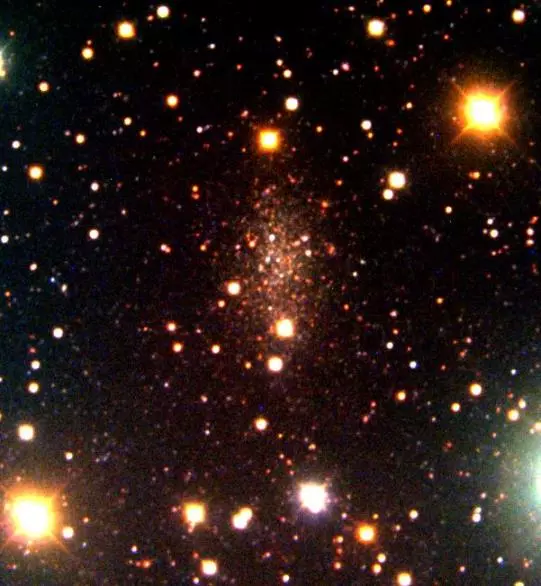
Pisces Dwarf, image: Deidre A. Hunter (CC BY-SA 2.5)
Most of the galaxy’s stars were formed about 8 billion years ago and the star formation rate has been on the decline for the last 10 billion years. Young hot stars can, however, be found in small clusters in the outer regions of the galaxy.
The Pisces Dwarf was discovered by the Russian astronomer Valentina E. Karachentseva in 1976.
Arp 284 – NGC 7714 and NGC 7715
Arp 284 is a pair of interacting galaxies in Pisces, discovered by the English astronomer John Herschel in September 1830.
NGC 7714 is a spiral galaxy with an apparent magnitude of 12.2, and NGC 7715 is thought to be either an edge-on spiral or an irregular galaxy. A supernova, SN 1999dn, was discovered in NGC 7714 in September 1999.
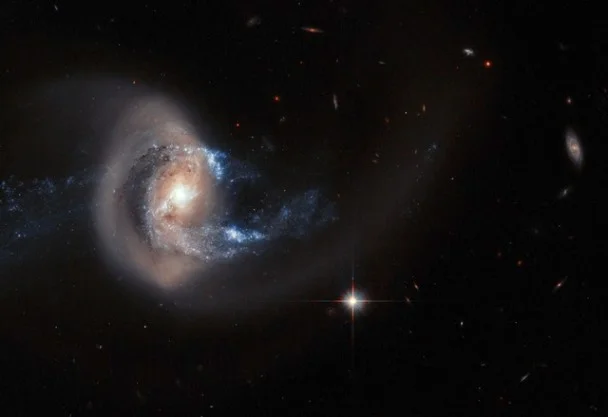
NGC 7714 is a spiral galaxy 100 million light-years from Earth — a relatively close neighbour in cosmic terms. The galaxy has witnessed some intense and dramatic events in its recent past. Tell-tale signs of this brutality can be seen in NGC 7714’s strangely shaped arms, and in the smoky golden haze that stretches out from the galactic centre — caused by an ongoing merger with its smaller galactic companion NGC 7715, which is off the top of the frame of this image. Image: NASA and ESA, A. Gal-Yam (Weizmann Institute of Science)
NGC 474
NGC 474 is a large elliptical galaxy. It is notable for its tidal tails, whose origin is unknown. The galaxy is approximately 100 million light years distant. A Type I supernova, designated SN 2017fgc, was discovered in the galaxy in July 2017.
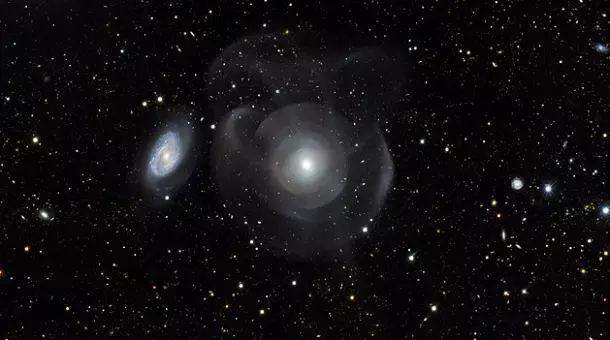
NGC 474, image: DES/DOE/Fermilab/NCSA & CTIO/NOIRLab/NSF/AURA. Acknowledgments: Image processing: DES, Jen Miller (Gemini Observatory/NSF’s NOIRLab), Travis Rector (University of Alaska Anchorage), Mahdi Zamani & Davide de Martin
NGC 520
NGC 520 is a pair of interacting spiral galaxies about 90.7 million light years from Earth. NGC 520 has an apparent magnitude of 12.2. It has an H II nucleus.
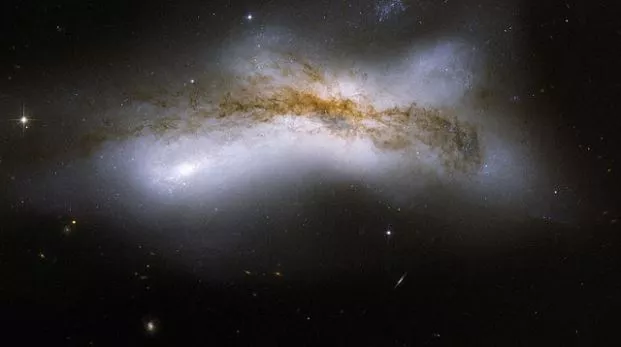
NGC 520 is the product of a collision between two disk galaxies that started 300 million years ago. It exemplifies the middle stages of the merging process: the disks of the parent galaxies have merged together, but the nuclei have not yet coalesced. It features an odd-looking tail of stars and a prominent dust lane that runs diagonally across the center of the image and obscures the galaxy. NGC 520 is one of the brightest galaxy pairs on the sky, and can be observed with a small telescope toward the constellation of Pisces, the Fish, having the appearance of a comet. It is about 100 million light-years away and about 100,000 light-years across. The galaxy pair is included in Arp’s catalog of peculiar galaxies as Arp 157. Image: NASA, ESA, the Hubble Heritage (STScI, AURA)-ESA, Hubble Collaboration, and B. Whitmore (STScI)
NGC 7459
NGC 7459 is a twin spiral galaxy, with two galactic nuclei only 15 arc seconds apart. The galaxy has an apparent magnitude of 15.2. It was first discovered by the American astronomer Lewis Swift in 1886.
NGC 514
NGC 514 is an intermediate spiral galaxy with an H II nucleus. It has an apparent magnitude of 12.2 and is approximately 95.9 million light years distant from the solar system.
NGC 57
NGC 57 is an elliptical galaxy. It has an apparent magnitude of 12.7. A magnitude 17 supernova was observed in the galaxy by Koichi Itagaki on June 3, 2010.
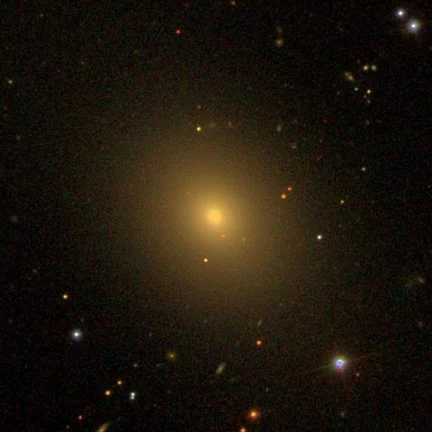
NGC 57, image: Sloan Digital Sky Survey
NGC 60
NGC 60 is a spiral galaxy in Pisces, notable for its unusually distorted spiral arms. Distorted spiral arms are usually the result of interactions and gravitational effects of nearby galaxies, but there are no galaxies in the vicinity of NGC 60 to explain this.
NGC 60 has an apparent magnitude of 14.85 and is approximately 500 million light years distant.